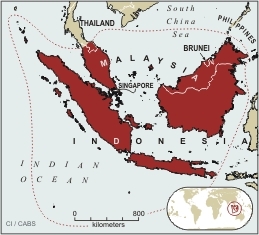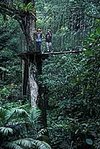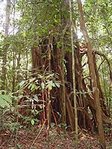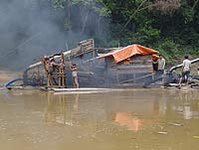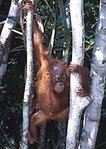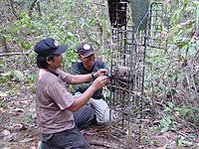Biological diversity in Sundaland
Biological diversity in Sundaland is exceptionally high, with the Sundaland Hotspot covering the western half of the Indo-Malayan archipelago, an arc of some 17,000 equatorial islands; moreover, this biodiversity hotspot is dominated by two of the largest islands in the world: Borneo (725,000 km2) and Sumatra (427,300 km2).
More than a million years ago, the islands of Sundaland were connected to mainland Asia. As sea levels rose during the Pleistocene, this connection periodically disappeared, eventually leading to the current isolation of the islands. The topography of the hotspot ranges from the hilly and mountainous regions of Sumatra and Borneo, where Mt. Kinabalu rises to 4101 meters, to the fertile volcanic soils of Java and Bali, the former dominated by 23 active volcanoes. Granite and limestone mountains rising to 2189 meters are the backbone of the Malay Peninsula.
Politically, Sundaland covers a small portion of southern Thailand (provinces of Pattani, Yala, and Narathiwat); nearly all of Malaysia (nearly all of Peninsular Malaysia and the East Malaysian states of Sarawak and Sabah in northern Borneo); Singapore at the tip of the Malay Peninsula; all of Brunei Darussalam; and all of the western half of the megadiversity country of Indonesia, including Kalimantan (the Indonesian portion of Borneo, Sumatra, Java, and Bali). The Nicobar Islands, which are under Indian jurisdiction, are also included.
Sundaland is bordered by three hotspots (Biodiversity hotspots (collection)). The boundary between the Sundaland Hotspot and the Indo-Burma Hotspot to the northwest is generally taken as the Kangar-Pattani Line, which crosses the Thailand-Malaysia border. Wallacea lies immediately to the east of the Sundaland Hotspot, separated by the famous Wallace's Line, while the 7100 islands of the Philippines Hotspot lie immediately to the northeast.
Lowland rainforests (Terrestrial biome) are dominated by the towering trees of the family Dipterocarpaceae. Sandy and rocky coastlines harbor stands of beach forest, while muddy shores are lined with mangrove forests, replaced inland by large peat swamp forests. In some places, ancient uplifted coral reefs support specialized forests tolerant of the high levels of calcium and Magnesium in these soils. Infertile tertiary sandstone ridges support heath forest. Higher elevations boast montane forests thick with moss, lichens, and orchids, while further up, scrubby subalpine forests are dominated by rhododendrons. At the very tops of the highest mountain peaks, the land is mostly rocky and without much vegetation.
Contents
Unique and Threatened Biodiversity
Plants
Sundaland is one of the biologically richest hotspots on Earth, holding about 25,000 species of vascular plants, 15,000 (60 percent) of which are found nowhere else. One plant family, the Scyphostegiaceae, is confined to the hotspots (Biodiversity hotspots (collection)) and is represented by a single tree species, Scyphostegia borneensis from Borneo. There are at least 117 endemic plant genera in the hotspot; 59 of these endemic genera are found in Borneo, 17 in Sumatra, and 41 on the Malay Peninsula.
Borneo boasts a spectacular diversity of trees. There are about 3000 species, including more than 265 species of dipterocarps; no less than 155 of these are endemic to the island. Borneo also has more than 2000 species of orchids. The other islands are less diverse than Borneo but still boast an impressive variety of plant life. Sumatran forests include more than 100 dipterocarp species, nearly a dozen of which are endemic, and Java has more than 270 endemic orchids.
Notable plants in the hotspot include members of the genus Rafflesia, represented by 16 species with very large flowers. One of these, Rafflesia arnoldii, has the largest flowers in the world, measuring up to one meter in diameter.
Vertebrates
Birds
Of the approximately 770 bird species that regularly occur in Sundaland, nearly 150 are endemic; around 40 of these endemic species are threatened. Borneo alone supports nearly 30 endemic species, most of which are montane species. As such, the Bornean Mountains, with 20 species confined to this EBA, are considered one of five Endemic Bird Areas (EBAs) recognized by BirdLife International in this hotspot, in addition to Sumatra and Peninsular Malaysia, Enggano, the Java and Bali Forests, and the Javan Coastal Zone.
Native species include the Bali starling (Leucopsar rothschildi, CR), a species endemic to Bali island and whose wild population fell to only six birds in 2001 due largely to trapping for the illegal cage-bird trade, and the Javan hawk-eagle (Spizaetus bartelsi, EN), estimated to number around 300-450 surviving pairs. The Javanese lapwing (Vanellus macropterus, CR), which once inhabited river deltas and marshes in the west and east, has not been recorded since 1940 and is considered Possibly Extinct.
Mammals
Of Sundaland's more than 380 mammal species, over 170 are endemic to the hotspot. In addition, 17 of 136 genera are endemic. Borneo boasts the most endemic mammal species of any island in the hotspot, with over 25 species found nowhere else. Of special interest are the four Mentawai Islands off the west coast of Sumatra (Siberut, Sipora, North Pagai, and South Pagai). These small islands, covering only 5,951 km2, are home to fully four endemic species of primates, including the endemic genus Simias, the pig-tailed langur.
Of all of Sundaland's diverse and threatened species, the best symbols of the vital need for conservation in the hotspot are its large mammals. The best known of these are the orangutans, represented by two species: the Bornean (Pongo pygmaeus, EN), and the Sumatran (Pongo abelii, CR), the latter of which had an estimated 3500 individuals surviving in the wild in Sumatra at the end of 2002. Orang-utans, which mature slowly and have a low reproductive rate, are threatened by habitat loss due to logging, fires, and agricultural conversion. Once reduced, their populations can take many years to recover.
Other famous flagships include the Proboscis monkey (Nasalis larvatus, EN), found only on Borneo, and two rhinoceros species, which are the most threatened and least known of the five surviving rhino species on Earth. The Javan rhino (Rhinoceros sondaicus, CR), which was once found throughout Southeast Asia, is now represented by only about 40-50 individuals, most surviving in Ujung Kulong National Park in West Java, with no more than six animals outside the hotspots (Biodiversity hotspots (collection)) in Nam Cat Tien National Park in Vietnam. The Sumatran rhino (Dicerorhinos sumatrensis, CR) ranged as far as Assam and Myanmar in the past. It is now believed to remain only in Sumatra, Peninsular Malaysia, and Sabah. Both rhinoceros species are severely threatened by poaching.
Reptiles
Reptile endemism is impressive in Sundaland. There are over 450 species of reptiles, roughly 250 of which are endemic, including 24 genera. There are also three endemic reptile families: two snake families, Anomochilidae and Xenophidiidae, and the monotypic Lanthanotidae, represented by the very rare and little known Bornean earless monitor lizard (Lanthanotus borneensis), a remnant of ancient fauna in the region. One of the most distinctive reptiles in the hotspot is the endemic false gharial (Tomistoma schlegelii, EN), a freshwater crocodilian species that can grow up to 4.7 meters in length and is found mostly in Sumatra and Borneo. Other threatened reptiles include two species of large river terrapins: the mangrove terrapin (Batagur baska, CR) and the painted terrapin (Callagur borneoensis, CR). Both species inhabit creeks and estuaries and have been extirpated from large portions of their range. The hotspot is also home to several Endangered and Vulnerable species of tortoises and freshwater turtles.
Amphibians
The Sundaland hotspot is home to more than 240 species of amphibians, nearly 200 of which are endemic. Seven genera are endemic, including the slender toads (Leptophryne, comprising two species), and three with single species: Pseudobufo, Phrynella, and Gastrophrynoides. The amphibian fauna of Sundaland remains extremely poorly known, and Sumatra, in particular, represents a very high research priority.
Freshwater Fishes
Nearly 200 species of fish have been discovered in the rivers, lakes and swamps of Sundaland in just the last decade. There are currently about 1000 known species of freshwater fish in the hotspots (Biodiversity hotspots (collection)) (out of a projected 1400), more than a quarter of which are restricted to one or more of the main islands. Once again, Borneo tops the list, with about 430 species, more than 160 of which are endemic. One of the best known fish species in the hotspot is the dramatic Asian bony tongue or golden arowana (Scleropages formosus, EN), a highly prized aquarium fish that can sell for thousands of dollars per animal.
Human Impacts
The most significant threat facing Sundaland's biodiversity is forest habitat destruction. Most deforestation has occurred in just the last three decades, a result of commercial logging and major agricultural projects in combination with government policies and small-scale agriculture. Some of the threats to the region's forests include rubber production, palm oil plantations, pulp production, and commercial and illegal logging. In Sumatra, illegal and unsustainable logging and non-timber forest product extraction are widespread, fueled by high demand from China, North America, Europe and Japan. The military and police are sometimes involved, as are paper industries, which obtain most of their wood from forests rather than plantations. Palm oil palm plantations are also an increasing threat to forests in the hotspots (Biodiversity hotspots (collection)). Increasing prices for palm oil led the government of Jambi Province, in Sumatra, to plan for the conversion of one million hectares of forest to palm oil; similar development is planned in other parts of Sumatra. Furthermore, the infamous Indonesian Transmigration Program, which moved people from more crowded areas of the country, such as Java, to the less populated islands, has accelerated pressures on biodiversity in some places. Rapid road construction increases the extent and speed of deforestation, by providing access for loggers, settlers and miners.
Particularly hard hit have been the more accessible lowland forests: recent estimates show that Kalimantan's protected lowland forests declined by 56 percent between 1985 and 2001, primarily from logging, and that less than 33 percent of lowland forest and peat swamp remains across all of Indonesian Borneo. At current deforestation rates, lowland forest in Sumatra and Kalimantan may soon disappear completely. Logging has been extensive in some protected areas; for example, forest loss averaged around two percent per year within Bukit Barisan Selatan National Park between 1985 and 1999, and as much as 9.5 percent per year in Gunung Palung National Park between 1999 and 2002.
In recent years, fires have become a major threat to the forests of Sundaland. Tropical forests do not naturally burn, but logging operations create flammable conditions by leaving fuelwood on the forest floor and by exposing the understory to drying. Fires are also sometimes intentionally lit to convert forests to oil palm plantations. Because few tropical plants are adapted to periodic fires, tropical forests are very slow to regenerate after burning. Under the intense exploitation pressure in the region, these forests may never return. In 1997, 15,000 square km2 in Sumatra and 30,000 km2 in Kalimantan were lost to fire.
Today, only around 700,000 km2 of forest remains, much of it highly fragmented. Only about 100,000 km2 remains in more or less intact condition, representing approximately seven percent of the original extent of the forest. Most of this remaining primary habitat is montane, and lies in the interior of Borneo and within a few protected areas in Sumatra, Peninsular Malaysia, and the southernmost portion of Thailand. Even these areas are under threat. In Sumatra, protected area management has been severely hampered due political developments in 2001: decentralization has delegated power to 78 local governmental structures, but responsibility for protected areas has remained with the central government, which has little authority or capacity for real enforcement or management.
One of the most insidious threats to the fauna of Sundaland is the wildlife trade (Convention on International Trade in Endangered Species of Wild Fauna and Flora (CITES)). Orangutan numbers were severely reduced in the past because of the pet trade. Today, tigers and rhinoceroses are the most visible targets of hunting for the Chinese medicine market, for skins, body parts, and horns. Turtles, snakes, geckos, pangolins, bears, and monkeys are exported by the ton from the region on a daily basis. Indonesia has long been the region's leading producer and exporter of snake leather. This trade has been surpassed in recent years by the export of live turtles to East Asia. Most turtle populations throughout the Sundaland hotspot are either in decline or have collapsed. Indonesia's massive cage bird trade has also placed a number of species such as Bali Starling and Straw-headed bulbul (Pycnonotus zeylanicus, VU) under serious threat; the latter species, once common across its range, is now confined largely to remote areas.
Conservation Action and Protected Areas
In all, around 180,000 km2 of land is protected throughout Sundaland, representing 12 percent of the hotspots (Biodiversity hotspots (collection)) total land area. However, only 77,000 square kilometers of this land (5.2 percent of the hotspot) is in protected areas in IUCN categories I to IV. Furthermore, the tendency throughout the hotspot has been to protect the least threatened, least used, and least valuable habitats, such as upper montane forests. The more diverse and important lowland forests are under-represented in the protected areas system and vulnerable to agricultural and timber development.
There is also wide variation in the actual levels of protection and management among parks and reserves. Some, such as Kinabalu in Sabah, Gunung Gede Pangrango in Java, and Hala-Bala in Thailand are well protected; others, such as Kutai National Park, have been entirely deforested through the effects of logging, drought and fire. To ensure long-term conservation, parks and reserves require effective implementation and enforcement of their protected status, as well as understanding and pride among the people of the region. At the same time, because of the high population density and growth rate within the hotspot, long-term, sustainable conservation will require a focus on social and economic development, education, and public awareness.
On Borneo, transboundary conservation areas, or peace parks, are being promoted as a form of international cooperation and ecosystem protection. For example, the Lanjak-Entimau Wildlife Sanctuary and the Batang Ai National Park in Sarawak are contiguous with the Gunung Bentuang and Karimun reserves in Kalimantan. Together they encompass a total of nearly 8,000 km2 of protected forestland. Other important clusters are Ulu Muda Forest Reserve, Hala-Bala Wildlife Sanctuary, Belum National Park, and Temengor Forest Reserve between Malaysia and Thailand.
Initiatives are also under way to expand existing in-country protected area networks. In 2004, the Indonesian government made a commitment to create 12 new protected areas. One of these was the Tesso Nilo/Bukit Tigapuluh landscape in central Sumatra, where the Critical Ecosystem Partnership Fund (CEPF) is supporting a corridor-level initiative to link four existing protected areas and one new protected area into a three-million-hectare haven of lowland forest. Such collaborative conservation efforts increase the effective size of protected areas to a great extent, but can only be effective in the long term if management strategies deal with the socio-economic and political drivers of land-use change. WWF-Indonesia is currently implementing two major initiatives within Tesso Nilo National Park with support from CEPF: the first involves protecting tigers from the wildlife trade, while the second involves developing and implementing a community based conservation plan.
The Indonesian government is implementing some policies to promote conservation. The central government is currently promoting a new policy to reduce the number of existing logging concessions by half. Some of these cancelled or abandoned concessions have been converted to protected areas, such as the Sebangau area in Central Kalimantan, while others will be designated for sustainable forest harvesting programs. In addition, a new policy allows for protected area creation by local governments rather than just the national government; this model, which promotes local ownership and stewardship, has already been used to create protected areas. For example, the 108,000 hectare Batang Gadis National Park, in northern Sumatra, was established as a locally managed protected area in early 2004. In May of the same year, the Ministry of Forestry declared the area a national park. Four local NGOs are currently working to develop biodiversity-friendly economic activities, and to involve communities adjacent to the park in management and conservation activities. CI is playing a coordinating role in the management of this park.
In central Sumatra, at Bukit Bahar, BirdLife Indonesia, the Royal Society for the Protection of Birds, the BirdLife International secretariat, and the Global Conservation Fund at Conservation International are pursuing another novel initiative by trying to acquire the rights to manage a logging concession, and establishing an endowment to ensure management in perpetuity. Not only would this be the first forest concession in Indonesia to be managed by an non-governmental organisation, but it would be the first license issued for the Indonesian government's far-sighted new legislation for concessions with solely conservation and restoration aims. This project will be an important test of the effectiveness and cost-efficiency of this as an alternative to conventional protected areas.
All of these efforts aid in safeguarding biodiversity. However, existing resources are inadequate to protect all forested areas and other natural habitats, leading to a need for prioritisation. One way of ensuring that the network of protected areas adequately conserves biodiversity is through the conservation of Key Biodiversity Areas, sites holding populations of globally threatened or geographically restricted species. In Sumatra, Conservation International-Indonesia and partners are in the process of identifying, delineating, and prioritizing among Key Biodiversity Areas.
Wildlife Conservation Society-Indonesia, in collaboration with |CI and local partners, is conducting an analysis of forest cover change in Sumatra over the past 10 years using remotely sensed data. With many years of investment in conservation research, community outreach, and training, WCS is poised to take their conservation activities to a new level through their Conservation Action Network Program, Indonesia (CANOPI). This program allows a broad network of local and international conservation groups to exchange information, coordinate field activities, and develop sustainable financing for protected area management.
Further Reading
- Birdlife International. 2003. Saving Asia's Threatened Birds: A Guide for Government and Civil Society. Cambridge: Birdlife International.
- Brook, B. W., Sodhi, N. S. & Ng, P. K. L. 2003. Catastrophic extinctions follow deforestation in Singapore. Nature 424: 420-423.
- Curran, L. M., Trigg, S., McDonald, A., Astiani, D., Hardiono, Y.M., Siregar, P., Caniago, I. & Kasischke, E. 2004. Lowland forest loss in protected areas of Indonesian Borneo. Science 303: 1000-1003.
- FWI/GFW. 2002. The State of the Forest: Indonesia. Bogor, Indonesia: Forest Watch Indonesia, & Washington DC: Global Forest Watch. ISBN: 1569734925.
- Kinnaird, M. F., Sanderson, E. W., O'Brien, T. G., Wibisono, H. T. & Woolmer, G. 2003. Deforestation trends in a tropical landscape and implications for endangered large mammals. Conservation Biology 17 245-257.
- Kottelat, M., & Whitten, T. 1996. Freshwater Biodiversity in Asia, with Special Reference to Fish. World Bank Technical Paper No. 343. Washington, D.C.: The World Bank. ISBN: 0821338080.
- Kottelat, M., Whitten, T., Kartikasari, S.J. & Wiryoatmodjo, S. 1996. Freshwater Fishes of Western Indonesia and Sulawesi. Periplus, Singapore.
- MacKinnon, J. & Philipps, K. 1993. Field Guide to the Birds of Sumatra, Borneo, Java and Bali. Oxford: Oxford University Press. ISBN: 0198540345.
- O'Brien, T. G. & Kinnaird, M. F. 2003. Caffeine and conservation. Science 300: 587.
- Rijksen, H. D. & Meijaard, E. 1999. Our Vanishing Relative. The Status of Wild Orang-utans at the Close of the Twentieth Century. Dordrecht, The Netherlands: Kluwer Academic Publishers. ISBN: 079235754X.
- Siegert, F., Ruecker, G., Hinrichs, A. & Hoffmann, A. A. 2001. Increased damage from fires in logged forests during droughts caused by El Nino. Nature 414: 437-440.
- van Steenis, C.G.G.J. 1950. The delimitation of Malesia and its main plant geographical divisions. Flora Malesiana Series 1:70-75.
- Whitmore, T.C. (Ed.). 1981. Wallace's Line and Plate Tectonics. Oxford: Oxford University Press. ISBN: 0198545452.
- Whitmore, T.C. (Ed.). 1984. Tropical Rain Forests of the Far East. 2nd edn. Oxford: Oxford University Press. ISBN: 0198542410.
- Whitten, T. 2002. Limestone biodiversity: Treasure houses of rare species. In E.D. Wikramanayake, E. Dinerstein, C. Loucks, D. Olson, J. Morrison, J. Lamoreux, M. McKnight & P. Hedao. Terrestrial Ecoregions of the Indo-Pacific: A Conservation Assessment. pp. 36-38. Washington, D.C.: Island Press. ISBN: 1559639237.
- Whitten, T., Damanik, S.J. & Anwar, J. 1987. The Ecology of Sumatra. 2nd edition. Yogyakarta: Gadjah Mada University Press. ISBN: 9794200611.
- Whitten, T. & Whitten, J. 1992. Wild Indonesia. London: New Holland Publishers. ISBN: 1853681288.
- Whitten, T., Soeriaatmadja, R.E., & Afiff, S.A. 1996. The Ecology of Java and Bali. Singapore: Periplus Editions. ISBN: 9625930728.
- Wich, S.A., Singleton, I., Utami-Atmoko, S.S., Geurts, M.L., Rijksen, H.D. & van Schaik, C.P. 2003. The status of the Sumatran orang-utan Pongo abelii: An update. Oryx 37: 49-54.
- Wikramanayake, E.D., Dinerstein, E., Loucks, C., Olson, D., Morrison, J., Lamoreux, J., McKnight, M., & Hedao, P. (Eds.). 2002. Terrestrial Ecoregions of the Indo-Pacific: A Conservation Assessment. Washington, D.C.: Island Press. ISBN: 1559639237.
- World Bank. 2001. Indonesia: Environment and Natural Resource Management in a Time of Transition. Washington, D.C.
See Also
| Disclaimer: This article contains information that was originally published by Conservation International. Topic editors and authors for the Encyclopedia of Earth have edited its content and added new information. The use of information from the Conservation International should not be construed as support for or endorsement by that organization for any new information added by EoE personnel, or for any editing of the original content. |

